Hunger games in a troubled land
DAKAR, January 13, 2015 - However fond you are of eggplant, would you really want to eat it at every single meal, in an infinite variety of preparations, mashed or whole, stuffed, grilled or baked, plain or marinated?
That was, in essence, the question facing me in late May 2010 as I prepared to take up a new job as AFP correspondent for the Palestinian territories, based in Jerusalem – after a string of assignments to the region, from 1995 as a journalism student, to 2009, via the second Intifada.
My musings on the subject were inspired by the story of Nasreddin Hodja, the figure of Oriental legend, who upon arriving at the court of the fearsome Emperor Tamerlane, introduced him to the plump, glossy vegetable so celebrated in Middle Eastern cuisine.
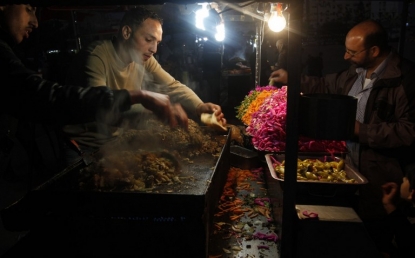 A fast food stall in Gaza City, January 2, 2013 (AFP Photo / Mohammed Abed)
A fast food stall in Gaza City, January 2, 2013 (AFP Photo / Mohammed Abed)Heeding his advice, the conquering sovereign demanded to be served eggplant – known to the British as aubergine – for breakfast, lunch and dinner. After two weeks of such a sickening diet – he banished the vegetable from his table, to cheers from his advisor.
Pressed by the ruler about his change of heart, Nasreddin replied: ‘Sire, I am here to serve Tamerlane, not the eggplant.’
Like the eggplant in the fable, for a journalist in Jerusalem the Israeli-Palestinian conflict is the main dish on the news menu, day in day out. In the Palestinian territories, virtually every story is directly linked to the conflict. Covering the story for four years – and far longer in the case of our local correspondents on both sides -- requires both a strong stomach and a fertile imagination, if you are to engage an international audience largely numbed by decades of intense media coverage – and avoid growing weary and frustrated yourself.
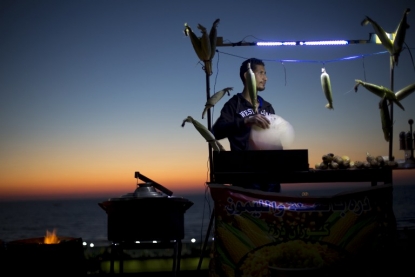 A seafront stall selling candy floss in Gaza City on May 14, 2014 (AFP Photo / Mohammed Abed)
A seafront stall selling candy floss in Gaza City on May 14, 2014 (AFP Photo / Mohammed Abed)On day one at my new job, on May 31, 2010, I was dragged out of bed by an early phone call about the death of nine Turkish activists in an Israeli raid on a flotilla trying to reach the Gaza Strip – controlled since 2007 by the Palestinian Islamists of Hamas – which threw open the debate on the severity, even the legitimacy, of Israel’s Gaza blockade.
Ostensibly aimed at keeping out goods with potential military uses, the embargo imposed by Israel – which controls all access points to the coastal enclave except the Rafah crossing into Egypt – banned the import of foodstuffs including coriander, cardamom, cumin, vinegar and chocolate.
Just days before the flotilla raid, the Israeli government press office sent a much-mocked email to the foreign press corps, stating that there was “no humanitarian crisis” in Gaza – and suggesting visiting reporters try a chic seafront restaurant in Gaza, the Roots, where “we have been told the beef stroganoff and cream of spinach soup are highly recommended.”
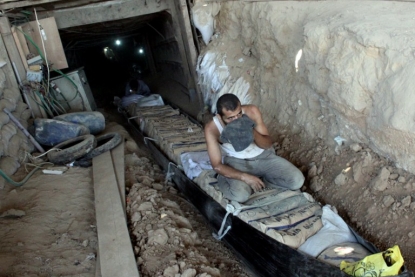 "Tunnels used for smuggling goods along the Gaza-Egypt border, on August 23, 2012 (AFP Photo / Mohammed Abed)
"Tunnels used for smuggling goods along the Gaza-Egypt border, on August 23, 2012 (AFP Photo / Mohammed Abed)No one is starving in the Gaza Strip – despite what some of the most zealous supporters of the Palestinian cause would have the world believe. The Israeli military administration even calculated precisely the number of calories per inhabitant needed to avoid malnutrition: 2,279 per day.
Daily consumer goods still find their way in – at the time mostly smuggled through tunnels running under the Egyptian border. When Israel eventually bowed to international pressure in the wake of the raid, and relaxed the embargo, the most noticeable consequence was to enable Gaza shopkeepers to expand their range of soft drinks, toiletries, chocolate and potato chips – according to a World Food Programme report issued the following year.
But the blockade, including the virtual ban since 2007 on Gaza exports to its natural markets in the West Bank and Israel, reduce the Palestinian enclave to a subsistence, aid-dependent economy – despite occasional exceptions to the ban, the latest implemented in November in the wake of the last Gaza war, allowing a shipment of cucumbers, tomatoes and fish.
 Salted herring on a street market in Gaza City, on August 5, 2013 (AFP Photo / Mohammed Abed)
Salted herring on a street market in Gaza City, on August 5, 2013 (AFP Photo / Mohammed Abed)The most extreme illustration, to my mind, of this transformation of the Gaza Strip into a belly destined to consume without producing was the launch in May 2013 of a Kentucky Fried Chicken delivery service – to be ordered in Egypt’s Sinai and ferried through the smuggler tunnels.
A media stunt as spectacular as it was to be short-lived: Hamas authorities called off the operation after a few weeks for “health and safety reasons”, the local firm’s manager told me, and the tunnels were sealed off soon after following the ouster of Egypt’s Islamist president Mohamed Morsi.
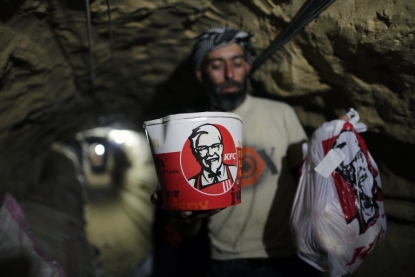 A smuggler carries Kentucky Fried Chicken food through a tunnel linking the Gaza Strip to Egypt (AFP Photo / Mohammed Abed)
A smuggler carries Kentucky Fried Chicken food through a tunnel linking the Gaza Strip to Egypt (AFP Photo / Mohammed Abed)Around the same time, in June 2013, a second fast-food story spotlighted another dimension to the conflict – this time in the West Bank.
The boss of the Israeli subsidiary of McDonald’s refused to open a restaurant in a shopping centre in the Ariel settlement – invoking a long-held company policy not to operate the other side of the Green Line, in occupied Palestinian territory. The decision infuriated the pro-settlement camp, already concerned by the spread of a global BDS – short for “Boycott, Divestment and Sanctions” – movement targeting Israel.
Sometimes the mere mention of a dish is enough to rub salt into the wound.
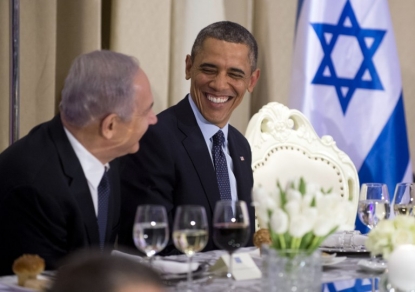
US President Barack Obama and Israeli Prime Minister Benjamin Netanyahu dine in Jerusalem, March 21, 2013
AFP Photo / Saul Loeb)
When US President Barack Obama visited the region in March 2013, the Palestinians half-choked on the news that regional specialties like hummus, falafel and tahini were served up to him under the banner of “Israeli cuisine”.
Incensed that Israel would “steal everything from us, even our food”, in the words of one demonstrator, they tried to turn the tables with a “100-Palestinian” meal – hummus, fava beans, falafel, kibbeh, stuffed vine leaves – served up in Obama’s honour at the Mukataa presidential compound in Ramallah.

Adding final touches to plates of hummus before Muslims break the Ramadan fast in Gaza City
on September 1, 2009 (AFP Photo / Mohammed Abed)
Hunger has also made more brutal apparitions in the conflict.
On March 19, 2014, a 15-year-old Palestinian boy was shot dead by Israeli troops, near an unfinished section of the West Bank separation barrier. He had come there with two friends to pick wild chard.
And at the start of Ramadan last June - as the Israeli army combed the West Bank hunting for the kidnappers of three teens, later found dead - it emerged it was also leaving lollipops for locals with a political message in Arabic on the wrapper, promising “a little sweetness after the bitterness Hamas has brought to your lives.” A sample of the kind of psychological warfare tools - along with flyers and phone calls - deployed by the military during each of Gaza campaign, to try to erode popular support for armed groups.
A few days later Israel launched its “Operation Protective Edge” in the Gaza Strip – the deadliest so far on both sides, and the first in a decade that I had no part in covering, having already left for a west Africa grappling with the Ebola epidemic and a resurgent Islamic extremist threat.
Selim Saheb Ettaba is currently AFP’s bureau chief in Dakar. He was based in Jerusalem, in charge of covering the Palestinian territories, from May 2010 to July 2014.
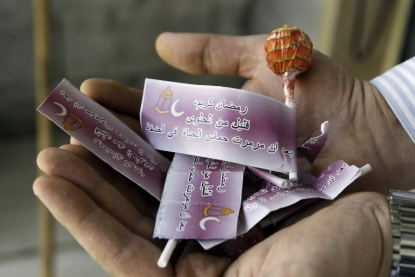 Lollipops distributed by Israeli soldiers at the Balata West Bank refugee camp on June 29, 2014 (AFP Photo / Jaafar Ashtiyeh)
Lollipops distributed by Israeli soldiers at the Balata West Bank refugee camp on June 29, 2014 (AFP Photo / Jaafar Ashtiyeh)

